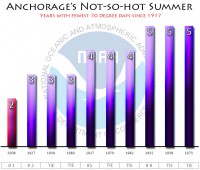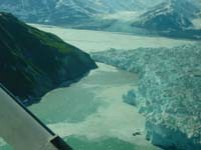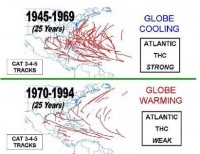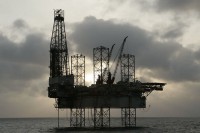Dec 04, 2008
The PDO not Greenhouse Gases are Responsible for Climate Changes in Alaska
By Joseph D’Aleo, CCM, Fellow AMS
The PDO has a major influence on Alaskan and for that matter global temperatures. The positive phase favors more El Ninos and a stronger Aleutian low and warm water in the north Pacific off the Alaskan coast. The negative phase more La Ninas and cold eastern Gulf of Alaska waters. The combination of a stronger Aleutian low and warm water off the coast leads to warmer temperatures in Alaska in the +PDO phase and a weakened Aleutian low, colder water, colder temperatures in the negative phase.
The PDO flip in 1977 from negative (which correlated with more frequent La Ninas) to positive (with more frequent El Ninos). More frequent La Ninas and weaker El Ninos followed the recent decline. In Alaska, the sudden Great Pacific Climate Shift (from negative to positive PDO) in 1977 led to a step-ladder warming.

We will update this after the annual 2008 temperatures become available in January. See larger image here.
The decline since 1999 and especially since 2007 has led to rapid cooling and heavy snows. Alyeska, Alaska picked up 826” (nearly 70 feet) of snow last snow season. This was followed by an extremely cold summer and a sudden advance of Alaskan Glaciers for the first time in 250 years.
Anchorage reached 65F only 16 times this past summer, tying the record set in 1970 for least 65F days. It broke the record for least 70F days with only 2.

See larger image here
With heavy winter snows and a cold spring and summer, the ice did not melt as much as usual - the result was a net annual advance in Alaskan glaciers.
As Michael Asher reported October 16, 2008 in Daily Tech, Alaskan Glaciers Grow for First Time in 250 years: A bitterly cold Alaskan summer has had surprising results. For the first time in the area’s recorded history, area glaciers have begun to expand, rather than shrink. Summer temperatures, which were some 3 degrees below average, allowed record levels of winter snow to remain much longer, leading to the increase in glacial mass.

And the cold continued this fall. This is part of a statement from the National Weather Service in Fairbanks on November 24th.
...A COLD START TO WINTER THIS YEAR AT FAIRBANKS…
October ended up as the 4th coldest in the last 104 years of weather record at Fairbanks. The total of 13 days with a low temperature below zero was the most since 1965. November has also been much colder than average. Through yesterday ...the average temperatures of -2.3 degrees was 7.3 degrees below the 30-year average. It has been the 8th coldest November in the last 50 years. There have been a total of 20 days So far this month where the temperature has fallen below zero...which is already above the average of 18 days for the entire month. Read more here.
UPDATE: Following this post we received this excellent paper (H/T Richard Keen) ”Monitoring Seasonal and Long-term Climate Changes and Extremes in the Central Alaska Network” by Pamela J. Sousanes that found this same PDO correlation as she demonstrated in this figure:

See larger image here.
Help Icecap do more to show these natural factors drive the climate - please see this letter.
Dec 04, 2008
Are Rising CO2 Levels And The Increase In Atlantic Major Hurricanes Since 1995 Related?
By Dr. William Gray
The official end of the 2008 Atlantic basin hurricane season occurred last Sunday (November 30). This year was an active and destructive season. My colleague, Phil Klotzbach and I were very happy to see that our forecasts for this year’s activity worked out well, as did NOAA’s seasonal hurricane forecast. See our website for a 53-page summary of this season’s activity. Although this is my 25th year of making these seasonal forecasts, Klotzbach should get most of the credit for the success of this year’s forecast.
President-Elect Barack Obama said last week that “storms are growing stronger with each passing hurricane season” (implying that this is due to CO2 increases). He is repeating what Al Gore has been saying for years and what was implied by thousands of media reports after the damaging Atlantic seasons of 2004-2005. Polls have shown that a relatively high percentage of US citizens think that human-induced global warming has increased hurricane activity.
Yes, the Atlantic has seen a very large increase in major hurricanes during the 14-year period of 1995-2008 (average 3.9 per year) in comparison to the prior 25-year period of 1970-1994 (average 1.5 per year). But, have rises in CO2 been, in any way, been responsible for the recent large upswing in Atlantic basin major hurricanes since 1995?
I and a number of my colleagues believe that this large increase in Atlantic major hurricanes is primarily due to the multi-decadal increase in the Atlantic Ocean Thermohaline Circulation (THC) that is driven by Atlantic salinity variations. These Atlantic multi-decadal changes have also been termed the Atlantic Multidecadal Oscillation (AMO). These increases are not a result of global surface temperatures or CO2 increases.
In the quarter-century period from 1945-1969 when the globe was undergoing a weak cooling trend, the Atlantic basin experienced 80 major (Cat 3-4-5) hurricanes and 201 major hurricane days. By contrast, in a similar 25-year period from 1970-1994 when the globe was undergoing a general warming trend, there were only 38 major hurricanes (48% as many) and 63 major hurricane days (31% as many). Atlantic sea surface temperatures and hurricane activity is related to but does not necessarily follow global mean temperature trends.

See larger image here.

See larger image here.
What made the 2004 and 2005 seasons so unusually destructive was not the high frequency of major hurricanes but the high percentage of hurricanes that were steered over the US coastline. Figure belows shows the contrast of the number of tracks of East Coast and Florida Peninsula major landfalling hurricanes during the 43-year period of 1923-1965 versus the most recent 43-year period of 1966-2008. Read full post here.
Nov 29, 2008
Russia Tells Obama: If You Don’t Drill, We Will
By MercoPress, 24 November 2008 [Courtesy CCNet and TWTW]
Russian oil companies could soon begin searching for oil in deep Gulf of Mexico waters off Cuba, a top diplomat said just days before Russian President Dmitry Medvedev visits the island. Russian oil companies have “concrete projects” for drilling in Cuba’s part of the gulf, said Mijail Kamynin, Russia’s ambassador to Cuba, to the state-run business magazine Opciones. Kamynin also said Russian companies would like to help build storage tanks for crude oil and to modernize Cuban pipelines, as well as play a role in Venezuelan efforts to refurbish a Soviet-era refinery in the port city of Cienfuegos, according the article published this weekend.
Medvedev comes to former Cold War ally Cuba on Thursday, part of a tour of Latin America to strengthen his country’s economic and political ties in the region. Kamynin said trade between Russia and the island would top 400 USD million this year. Washington’s nearly 50-year-old trade embargo prohibits US companies from investing on the island. But Cuba’s state-run oil concern has signed joint operating agreements with companies from several countries
to explore waters that Cuban scientists claim could contain reserves of up to 20 billion barrels of oil. Read more here.
\

Nov 28, 2008
Gore and the Mayan Civilization Collapse - Gore is Advocating Abandoning IPCC
Richard Mackey, Statistician
"The following appeared on Gore’s website of Nov 19, 2008: Looking Back to Look Forward
A new study suggests the Mayan civilization might have collapsed due to environmental disasters:
“These models suggest that as ecosystems were destroyed by mismanagement or were transformed by global climatic shifts, the depletion of agricultural and wild foods eventually contributed to the failure of the Maya sociopolitical system,’ writes environmental archaeologist Kitty Emery of the Florida Museum of Natural History in the current Human Ecology journal.” As we move towards solving the climate crisis, we need to remember the consequences to civilizations that refused to take environmental concerns seriously. If you haven’t read already read it, take a look at Jared Diamond’s book, Collapse.”

This is a most curious reference.
It means that Gore is advocating the abandonment of the IPCC doctrine and barracking for the study and understanding of climate dynamics that ignores totally the IPCC/AWG doctrine and focuses on all the other variables, especially how climate dynamics are driven by atmospheric/oceanic oscillations, the natural internal dynamics of the climate system and the role of the Sun in climate dynamics.
Brian Fagan in Floods, Famines and Emperors, El Nino and the fate of civilisations, Basic Books 1999, shows that the Maya collapse, whilst having complex political, sociological, technological and ecological factors, was largely driven by the natural atmospheric/oceanic oscillations of ENSO and NAO. The book is one of three by Brian Fagan, Professor of Anthropology UC Santa Barbara, that documents how natural climate variations, ultimately driven by solar activity, have given rise to the catastrophic collapse of civilisations. The book has a chapter on the Mayan civilisation which collapsed around 800 to 900 AD.
Here are some quotes from his book:
“The “Classic Maya collapse” is one of the great controversies of archaeology, but there is little doubt that droughts, fuelled in part by El Nino, played an important role.” “The droughts that afflicted the Maya in the eighth and ninth centuries resulte from complex, still little understood atmosphere-ocean interactions, including El Nino events and major decadal shifts in the North Atlantic Oscillation, as well as two or three decade-long variations in rainfall over many centuries.” Read more here.
Nov 28, 2008
International Poll: ‘Growing Public Reluctance’ to Support Global Warming Efforts
Peter O’Neil, Europe Correspondent, Canwest News Service
There is both growing public reluctance to make personal sacrifices and a distinct lack of enthusiasm for the major international efforts now underway to battle climate change, according to findings of a poll of 12,000 citizens in 11 countries, including Canada.
Results of the poll were released this week in advance of the start of a major international conference in Poland where delegates are considering steps toward a new international climate-change treaty to replace the Kyoto Protocol, which expires in 2012. There already are reports emerging that some countries, such as coal-dependent Poland, are pushing for special treatment to avoid making major commitments to slash carbon emissions during a global economic downturn. A file photo showd snow cannons blasting artificial snow on a slope in Kitzbuehel, Austria. Due to the uncommonly warm weather many European alpine ski resorts have no snow.
Less than half of those surveyed, or 47 per cent, said they were prepared to make personal lifestyle changes to reduce carbon emissions, down from 58 per cent last year. Only 37 per cent said they were willing to spend “extra time” on the effort, an eight-point drop.And only one in five respondents - or 20 per cent - said they’d spend extra money to reduce climate change. That’s down from 28 per cent a year ago. The Canadian results, from a poll of 1,000 respondents conducted in September, were virtually identical to the overall figures. There are no comparative figures for Canada because Canadians weren’t included in the global study in 2007.The 11 countries surveyed were Australia, Brazil, Canada, China, France, Germany, India, Malaysia, Mexico, the United Kingdom and the United States. There were 2,000 respondents surveyed in China, including 1,000 in Hong Kong.The survey was conducted as part of a joint collaboration between the financial institution HSBC and environmental groups, such as the Earthwatch Institute."There’s consumer reluctance that’s creeping in, and we’ve seen that some are being stunned into inaction by the enormity of the task,” said Earthwatch executive vice-president Nigel Winser.
Results of the poll suggested that 55 per cent of respondents in the 11 countries said their governments should be doing more by investing in renewable energy sources, such as wind, solar and wave power. That’s more than double the 27 per cent who wanted their governments to participate in Kyoto-style international agreements to reduce emissions. In Canada, the same portion favoured renewable-energy options, while 32 per cent supported collective international efforts. “People believe governments are focusing too much attention on indirect actions that pass responsibility for climate change onto others, such as increasing taxes on fossil fuels, encouraging individual environmentally friendly activities and participating in international negotiations, such as the Kyoto Protocol,” the report said.
“More needs to be done to inform consumers about measures such as green taxation or carbon trading to help them understand how tangible these can be. “The poll helps explain why outgoing Liberal Leader Stephane Dion had so much difficulty during the election campaign trying to sell his Green Shift platform that proposed a carbon tax in order to encourage emission reductions. Earthwatch’s Winser said the silver lining in the poll was that it stresses public dissatisfaction with the performance of all governments. “We welcome this survey because it shows that individuals want their governments to do more."HSBC was unable to provide the poll’s margin of error. Read post here.
|










